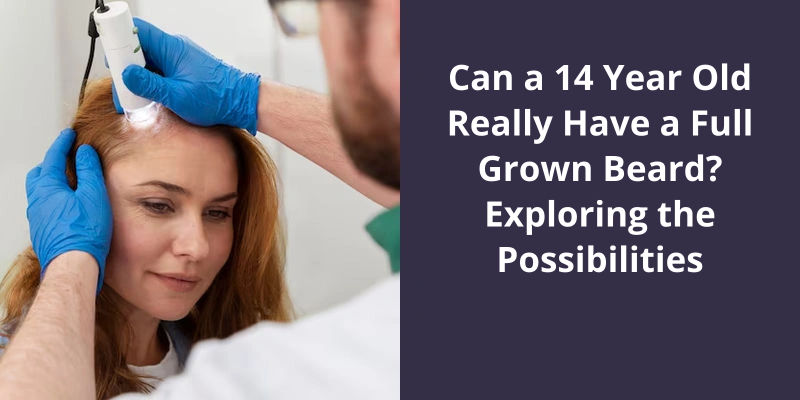A 14-year-old potentially can have a full-grown beard, but it is not very common. The growth of facial hair largely depends on a person’s individual genetics and the onset of puberty. Some young teens can start to see facial hair growth if they hit puberty at an early age, however, a fully grown and thick beard is generally a feature that develops later in the teenage to early adult years. Even then, the thickness and coverage of the beard vary from person to person. It is also important to remember that everyone develops at their own pace, and lack of a beard at 14 is no cause for concern.

Is It Rare to Grow a Beard at 14?
Facial hair growth is dependent on a variety of factors, including genetics, ethnicity, and hormonal changes. Some boys may start growing facial hair earlier or later than others, and the thickness and density of the hair can also vary.
It’s also important to consider cultural and societal norms around facial hair, as some communities may view facial hair as a sign of maturity or masculinity, while others may see it as unkempt or inappropriate for young people.
For those who do want to encourage facial hair growth, there are a variety of products and techniques that can be used to stimulate hair growth and improve overall hair health. This includes dietary changes, such as increasing intake of vitamins and minerals like biotin and zinc, as well as using specialized hair products like beard oils and conditioners. It’s important to approach these methods with caution, however, as some products may be ineffective or even harmful if used improperly.
Ultimately, whether or not a 14-year-old should grow a beard is a personal decision that should be made in consultation with parents, peers, and cultural norms. While some may feel more confident with facial hair, others may feel uncomfortable or be subject to negative reactions from those around them. It’s important to respect the personal choices of individuals and not to judge based on appearance or societal beliefs. what matters most isn’t the presence or absence of facial hair, but the character and personality of the individual.
The Role of Testosterone and Other Hormones in Facial Hair Growth
Facial hair growth is influenced by hormones, specifically testosterone, which is a male hormone that promotes the development of secondary sexual characteristics, including facial hair growth. Testosterone stimulates hair follicles to produce new hair and increases the density of facial hair that already exists. Other hormones, such as dihydrotestosterone, also play a role in facial hair growth. Differences in hormone levels between males and females account for the difference in facial hair growth between the sexes.
Aside from genetics, there are other factors that can determine when and how much facial hair a person can grow. One of these is ethnicity, which can affect the density and pattern of hair growth on the face. Understanding the science behind beard growth can provide insights into why some people may have more pronounced facial hair than others, and when to expect your own beard to reach it’s full potential.
What Age Does Your Beard Stop Filling In?
For example, men of Asian, Native American, and Latinx descent typically have less facial hair than men of European or African descent. However, there are always exceptions to these generalizations, and it’s important to remember that everyones beard journey is different.
One thing to keep in mind is that the rate of beard growth can vary greatly from person to person. Some men are able to grow a full beard in just a few weeks, while others may take several months or even years to achieve the same level of growth. This is why it’s important to be patient and not get discouraged if your beard isnt filling in as quickly as youd like.
Another factor that can affect when your beard stops filling in is lifestyle habits. Smoking, for example, can inhibit hair growth and cause premature graying. Stress and poor nutrition can also have a negative effect on beard growth and overall hair health. Maintaining a healthy diet, getting enough sleep, and managing stress can all help promote healthy beard growth.
Of course, grooming and maintenance also play a key role in the appearance of your beard. Regular trimming can help keep your beard looking neat and tidy as it grows in, while using products like beard oil and balm can help keep your hair and skin healthy and moisturized. It’s also important to avoid over-styling your beard, as this can cause damage and breakage.
Ultimately, there’s no one-size-fits-all answer to when your beard will stop filling in. The best approach is to be patient, take care of your beard, and let nature take it’s course. With time and proper care, your beard will reach it’s full potential and become a source of pride and confidence.
Source: Can’t Grow a Full Beard? There’s an Explanation for That
Now that we know that having facial hair doesn’t necessarily mean that we’ve stopped growing taller, let’s take a closer look at the factors that can determine our overall height and whether or not genetics play a significant role in our growth.
Can You Grow Taller if You Have a Beard?
Growth in height is determined by genetic factors and environmental factors, such as nutrition and exercise. If your growth plates, which are responsible for bone growth, haven’t yet fused, you can potentially grow taller.
Having a beard isn’t directly related to height growth. It’s simply a sign of maturation and the onset of puberty. Additionally, there are many adult men who don’t have facial hair but are still able to grow taller.
A balanced diet with adequate protein and vitamins can help support bone growth, while sufficient sleep and regular exercise can also promote healthy bone development. Hormones such as human growth hormone (HGH) and testosterone can also play a role in height growth, as they stimulate bone growth and maturation.
In some cases, medical conditions such as hypothyroidism or growth hormone deficiencies can lead to stunted growth in height. If you’re concerned about your height or facial hair growth, it’s important to consult with a healthcare professional who can provide you with a proper diagnosis and treatment options. Additionally, if you’re experiencing delayed puberty, your doctor may recommend hormone therapy to help stimulate growth and development.
The Social and Cultural Significance of Beards and Other Physical Characteristics in Different Parts of the World.
- Beards have played a significant role in religious traditions, such as in Islam where it’s encouraged for men to grow a beard
- In many cultures, a full beard is a sign of masculinity and virility
- In ancient Greece, beards were seen as a symbol of wisdom and power, and were often worn by philosophers and statesmen
- In some Native American cultures, facial hair was seen as a sign of respect and honor
- In modern times, beards have become more of a fashion statement and a way to express individuality
- Other physical characteristics, such as height, weight, and skin color, have also been significant in different parts of the world and have been used to make assumptions about one’s character and abilities
- Overall, social and cultural attitudes towards physical characteristics vary greatly across different cultures and time periods
Conclusion
It’s also important to take proper care of facial hair to prevent skin irritation and maintain it’s health. Regardless of age, it’s important to embrace and love oneself for who they are, with or without facial hair.





